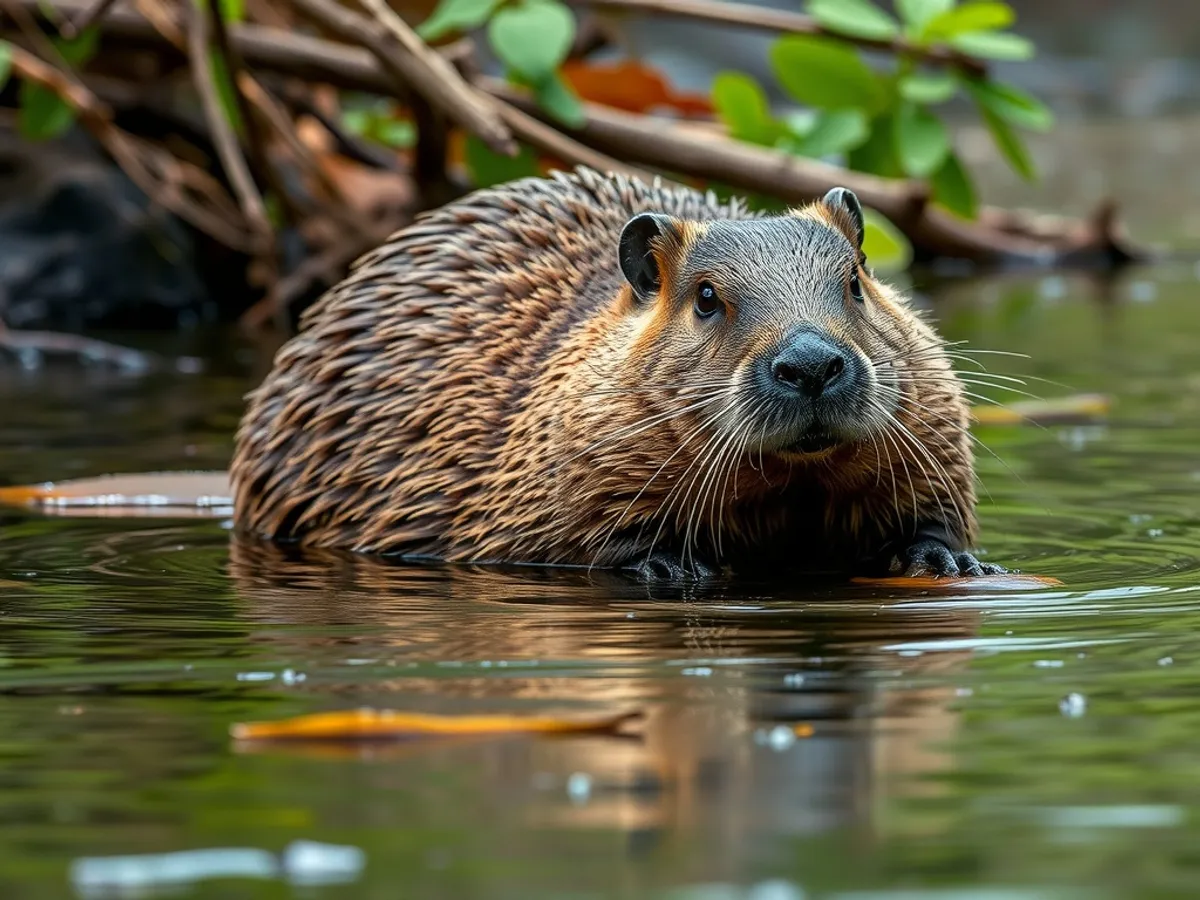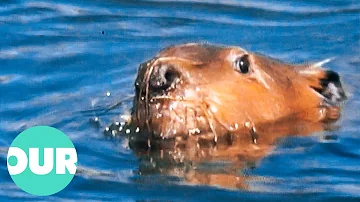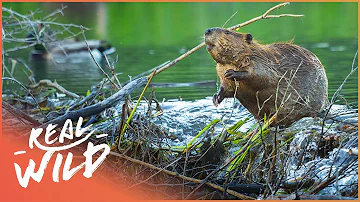
American Beaver
Castor canadensis

Meet the American Beaver
The American Beaver is the largest rodent in North America, known for its powerful build, webbed feet, and iconic flat, paddle-shaped tail. Renowned for its remarkable engineering skills, this semi-aquatic mammal constructs complex lodges and dams using branches, mud, and stones, profoundly shaping freshwater ecosystems. Beavers play a vital ecological role by creating wetlands, which help support diverse plant and animal communities. Their dense, waterproof fur and skilled swimming abilities allow them to thrive in ponds, rivers, and streams across much of North America.
Classification
Mammal
Habitat
Freshwater rivers, streams, ponds, and lakes in forested and mixed woodland regions
Diet
Herbivore
Lifespan
10-15 years in the wild
Conservation
Least Concern
Weight
16-32 kg (35-70 lbs)
📖Fascinating Facts
Iron-rich Teeth
The American Beaver's teeth contain iron, which gives them an orange color and allows them to gnaw through tough wood efficiently.
Expert Builders
Beavers build dams and lodges to create deep, calm water, which protects them from predators and provides a stable habitat.
Ecosystem Engineers
Their dam-building activities create wetlands that support biodiversity, help filter water, and reduce downstream flooding.
📋Detailed Description
The American beaver (Castor canadensis) is a robust, semi-aquatic rodent, typically weighing between 16 and 32 kg (35–70 lbs), with exceptional individuals exceeding 40 kg (88 lbs). Adults measure 90–120 cm (35–47 in) in length, including a broad, scaly tail that can reach up to 35 cm (14 in). Their dense, double-layered fur provides insulation and waterproofing, while large, webbed hind feet and a streamlined body facilitate powerful swimming. Beavers possess continuously growing incisors, orange due to iron-rich enamel, which are essential for gnawing through wood. Their nostrils and ears can close underwater, and a transparent nictitating membrane protects their eyes while submerged. Beavers are primarily crepuscular, active during twilight and nighttime hours. They are renowned ecosystem engineers, constructing elaborate dams and lodges from wood, mud, and stones, which create ponds that support diverse wetland habitats. Socially, beavers live in monogamous family groups, or colonies, typically consisting of a breeding pair, their current-year offspring (kits), and yearlings from the previous year. These colonies maintain and defend territories marked with castoreum, a scent produced by specialized glands.
💡 Did you know?
Beaver dams are visible from space and can reach lengths of over 850 meters (2,790 feet), making them some of the largest animal-made structures on Earth.
🔬Research & Sources
Wikipedia Summary
The North American beaver is one of two extant beaver species, along with the Eurasian beaver. It is native to North America and has been introduced in South America (Patagonia) and Europe. The North American beaver is one of the national symbols of Canada and the official state mammal of Oregon and New York. North American (Canadian) beavers are widespread across the continental United States, Canada, southern Alaska, and some parts of northern Mexico.
Last Modified: 6/11/2025
🎭Behavior & Social Structure
American beavers are highly territorial and exhibit complex social behaviors within their colonies. They communicate using vocalizations, scent marking, tail slapping on water as an alarm signal, and physical grooming. Feeding primarily on the bark, cambium, leaves, and twigs of deciduous trees such as aspen, willow, birch, and poplar, they also consume aquatic plants and roots. Beavers practice food caching, storing branches underwater near their lodges for winter consumption. Their daily routine includes foraging, dam and lodge maintenance, and grooming. Beavers are known for their ability to alter landscapes: by felling trees and building dams, they create ponds that provide protection from predators and access to food. These engineered habitats increase local biodiversity and influence hydrological processes.
👶Reproduction & Life Cycle
Beavers are monogamous, forming long-term pair bonds, though replacement of mates can occur after death. Breeding typically occurs between January and March, depending on latitude. After a gestation period of about 105–107 days, females give birth to 1–6 kits (average 2–4) in late spring (April–June). Kits are born fully furred and with open eyes, and are capable swimmers within 24 hours. Both parents participate in rearing, with older siblings sometimes assisting. Kits nurse for 6–8 weeks but begin sampling solid food within their first week. Juveniles remain with the family for up to two years before dispersing to establish their own territories.
🛡️Adaptations & Survival
American beavers exhibit a suite of adaptations for aquatic life and woodcutting. Their webbed hind feet and flattened tail provide propulsion and steering in water, while dense fur and a layer of subcutaneous fat offer insulation. The lips can close behind the incisors, allowing underwater gnawing. Beavers have highly developed kidneys for conserving water and can remain submerged for up to 15 minutes due to efficient oxygen storage and reduced heart rate. Their incisors grow continuously to compensate for constant wear. Behavioral adaptations include dam and lodge construction, food caching, and territorial scent marking. Evolutionarily, beavers are specialized for ecosystem engineering, with behaviors that profoundly alter their environment.
🎨Cultural Significance
The American beaver holds significant cultural and economic importance. It is a national symbol of Canada, appearing on coins, emblems, and as a mascot for Parks Canada. The beaver was central to the North American fur trade, shaping early colonial economies and exploration routes. Indigenous peoples have long valued beavers for their pelts, meat, and castoreum, and feature them in folklore as symbols of industriousness and transformation. In modern times, beavers are recognized for their ecological services, such as wetland creation, water purification, and flood mitigation, and are increasingly appreciated in conservation and restoration projects.
🔬Recent Research & Discoveries
Recent research has highlighted the beaver's role as a keystone species, with studies demonstrating their positive impacts on biodiversity, water quality, and climate resilience. Genetic analyses have clarified the distinction between North American and Eurasian beavers, confirming limited hybridization. Ongoing research explores beaver-mediated restoration of degraded streams, carbon sequestration in beaver ponds, and the effects of beaver activity on fish populations. Innovative management strategies are being developed to mitigate human-beaver conflicts, such as flow devices ('beaver deceivers') that prevent unwanted flooding while allowing beavers to persist. Studies on beaver social structure and dispersal patterns are providing insights into population dynamics and landscape connectivity.
🎥Wildlife Videos

American Beaver | Awesome Animals
Second only to humans, beavers alter their environment more than any other organism on the planet. These tireless animal ...
Nat Geo Kids

Busy Beavers Build Dam Ahead of Winter | Yellowstone | BBC Earth
Autumn is the busiest time of the year for beavers – dams must be built in order to ensure they can survive the harsh winter ...
BBC Earth

The Secret World Of The North American Beaver | Our World
We see him at work, at play and in moments of danger, threatened by human fur trappers, marauding lions and a grizzly bear.
Our World

Beaver Lodge Construction Squad | Attenborough | BBC Earth
From the BBC's Life of Mammals documentary series. WATCH MORE: New on Earth: https://bit.ly/2M3La96 Oceanscapes: ...
BBC Earth

Why Do Beavers Build Dams? Nature's Engineers (Wildlife Documentary) | Natural Kingdom | Real Wild
This is the story of Nature's Extreme Machine, the miracle engineer. We study the behavior of the Beaver from Argentina to Alberta ...
Real Wild

Beaver Pond Wildlife: Part 1 - Early Spring
Interested in observing a wide variety of wildlife? There are few, if any, better places to sit down and quietly watch for mammals, ...
New England Forests
🌍Habitat Information
The American Beaver typically inhabits Freshwater rivers, streams, ponds, and lakes in forested and mixed woodland regions environments. American Beavers have adapted to their environments with specialized features and behaviors.
Primary Habitat:
Freshwater rivers, streams, ponds, and lakes in forested and mixed woodland regions
More detailed habitat information will be available soon.
🛡️Conservation Status
The American Beaver is currently classified as Least Concern. Conservation efforts are crucial for preserving this species for future generations.
Common Threats:
- 🏠Habitat loss and fragmentation
- 🌡️Climate change impacts
- 🎯Hunting and poaching
- 🏭Human-wildlife conflict
⚠️Threats & Conservation Challenges
Historically, beaver populations were drastically reduced by unregulated trapping for fur and castoreum, habitat loss, and persecution as pests. By the early 20th century, populations reached near-extirpation in many regions. Conservation measures, legal protections, and reintroductions have enabled substantial recovery, and the species is now classified as Least Concern. Current threats include habitat fragmentation, water pollution, climate change affecting hydrology, and localized conflicts with humans (e.g., flooding of infrastructure, crop damage). Invasive beaver populations in South America have caused significant ecological disruption. Overall, North American populations are stable or increasing, but continued management is necessary to balance ecological benefits and human interests.
🔬Scientific Classification
Scientific Name
Castor canadensis
Classification Hierarchy
🔍 About Taxonomic Classification
Taxonomic classification is a hierarchical system used by scientists to classify and organize living organisms based on shared characteristics and evolutionary relationships.
The system moves from broad categories (Kingdom) to increasingly specific ones, with each animal's scientific name typically consisting of its Genus and species.
📝Community Notes
Share your observations and insights about the American Beaver with our community of wildlife enthusiasts.
Join Our Community
Sign in to share your observations and connect with fellow wildlife enthusiasts.
Sign In to ContributeNo community notes yet
Be the first to share your observations about the American Beaver!
Explore American Beaver
Select a tab above to learn more about this amazing animal.
📸Photo Gallery
No photos available for this animal yet.
🌟Discover More Wildlife
Continue your journey of discovery with more fascinating animals from our database
